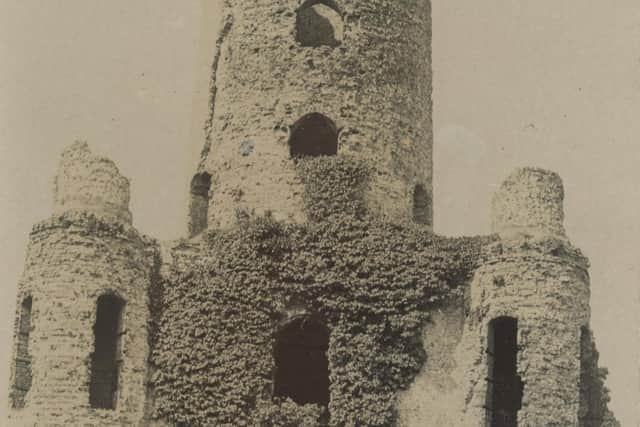Racton Ruin: Story of a strange tower in South Downs National Park, said to be one of the spookiest places in Sussex
and live on Freeview channel 276
Initially called Stansted Castle, Racton Ruin was completed in the 1770s and it stands in what was the Stansted Estate. The tower is a folly and it was originally built for the third Lord Halifax, who lived nearby in Stansted House.
Sometimes known as Racton Tower, it was intended to provide a visual statement in the landscape, easily seen from Stansted House and from the surrounding countryside.
Advertisement
Hide AdAdvertisement
Hide AdThe architectural feature, designed by Theodosius Keene, looked like a cross between a castle and a pagoda, with turrets at each of its three points and a small spire on top. Built of red brick, the walls were originally faced with flints but most have since disappeared.


The lower floor was used as a banqueting hall and the tower allowed guests to take advantage of the spectacular views of the Solent and beyond from the upper floors.
The view was described in 1772 as 'from the leads of the upper storey the eye takes in an unbounded prospect over that part of Sussex which lies between the Downs and the coast to the east and south, and beyond the Isle of Wight to the westward, having a clear view of the British Channel in an uninterrupted line from point to point'.
Advertisement
Hide AdAdvertisement
Hide AdThe owner ordered that the building be demolished 'sometime after 1782' but this was carried out only partially, as subsequently the stonework, roof and floors were removed. The rest remained, however there was rapid deterioration to the turrets and walls.


There have been reports of paranormal activity at this isolated folly, including bricks being thrown from the top of the tower and a ghostly woman wandering the lanes. According to local legend, there is a ghost tractor in the fields that comes right up to you, then disappears.
The tower was put on the market by Chichester Rural Council in 1972 and bought by a London doctor the following year. In 1978 it was up for sale again and an anonymous Greek bought it prior to it being auctioned. Architect Mark Talbot has been the owner of this grade-two listed building since 1987.
In 1989, Chichester District Council archaeologist James Kenny discovered a 4,000-year-old Bronze Age skeleton and 25 years later, in December 2014, scientists revealed so-called Racton Man could have been one of our early rulers who died in combat.
Advertisement
Hide AdAdvertisement
Hide AdMonths of research, during which his teeth, bones and dagger were analysed, showed he was probably a tribal leader aged 45, from the very beginning of the Bronze Age. Analysis of the dagger showed it was bronze and so it would have been incredibly rare at the time.
After inspecting the bones, the London Institute of Archaeology suggested he was 6ft and suffered spinal degeneration, thought to be age-related. Scientists also found he suffered from a chronic sinus infection, as well as an abscess and tooth decay.
A cut to his right upper arm suggested he was trying to protect himself from a blow, which led scientists to believe the dagger was not just for display. What made the dagger so stunning was the rivet-studded hilt. The design was distinctively British but of greater significance was the fact it dated to the transition from copper to bronze metallurgy.
Racton Man is on display at The Novium Museum in Chichester. Investigation of the discovery was carried out in collaboration with the museum after funding of almost £2,000 from the South Downs National Park Authorities Sustainable Communities Fund was secured in February 2014 and a team of specialists was put together.
Advertisement
Hide AdAdvertisement
Hide AdThe museum explains a metal detector found a dagger blade and a number of rivets, then a scheduled excavation revealed a complete crouched burial with a number of additional rivets. The individual was of robust and athletic build and had been buried with a dagger some time in the Bronze Age.
The funding enabled thorough investigation of the archive, including radio-carbon dating and isotope analysis and osteological assessment of the human remains to see whether the person had ever suffered illness or injury during his life. There was also x-ray fluorescence of the dagger to ascertain the dominant metal, and establish whether it comprises copper or bronze. The results were staggering.
Radiocarbon dating of the remains was undertaken by the Scottish Universities Environmental Research Centre in Glasgow and suggested that Racton Man died sometime in the period 2300BC to 2150BC. Isotope analysis on one of the teeth by experts from Durham University reveal that he could have been brought up in southern Britain, possibly somewhere to the west of Sussex.
Evidence was found of a peri-mortem cut, at or near the time of death, to the right upper arm bone, close to the elbow. This is consistent with the arm being raised, elbow bent above the head, to protect it from a blow or strike from a weapon.
Advertisement
Hide AdAdvertisement
Hide AdThe museum says these indications of actual fighting suggest Racton Man's dagger was not just for display. His social position may have depended on him demonstrating his prowess in combat.
There is also evidence of a similar blow having struck the lower part of the right shoulder, under the armpit. A sharp force blow would have been consistent with a double strike – one to the head, blocked by the raised right arm, and a second deep into the armpit, presumably to sever major blood vessels.